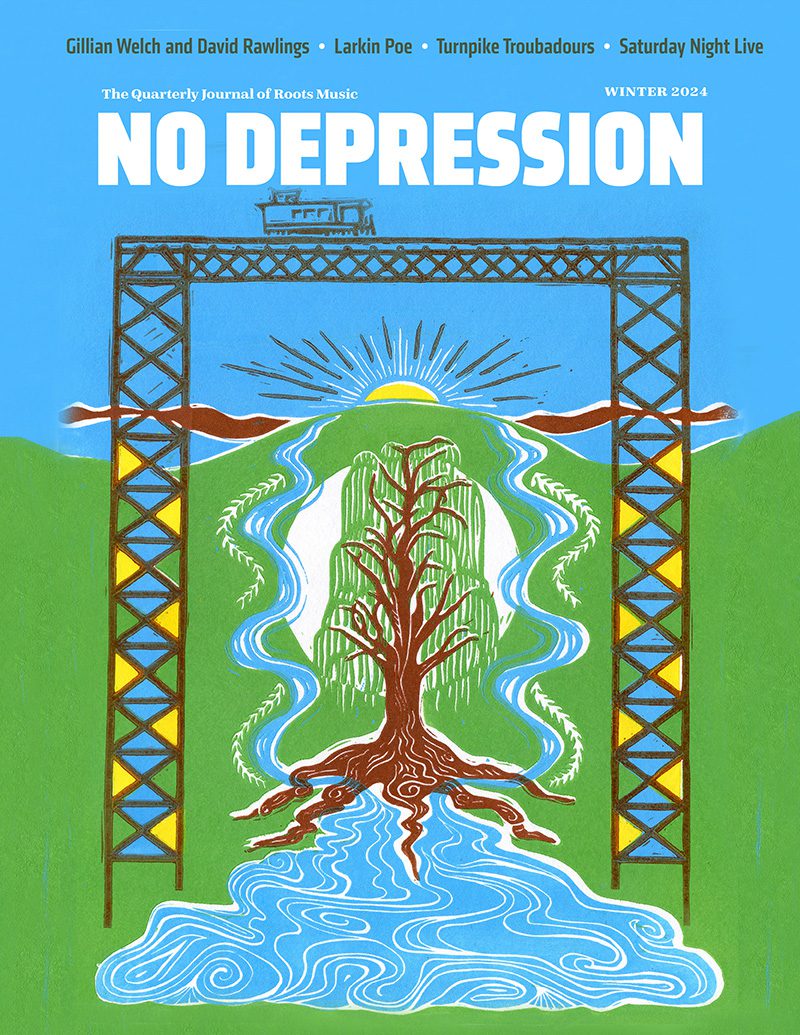T Bone Burnett – Staking his reputation on well-done records
Though folks such as Brian Paulson and Eric Ambel have probably set the standards in recent years for producing acts that follow a more country/roots-oriented approach to rock ‘n’ roll, it’s hard to compete with the credits T Bone Burnett compiled in the first half of 1996, in terms of both quality and quantity.
Four of the best releases of the year so far — Gillian Welch’s Revival, Jimmie Dale Gilmore’s Braver Newer World, the Wallflowers’ Bringing Down the Horse, and Daniel Tashian’s Sweetie –were produced by Burnett. It’s a rather varied quartet of projects, though all four share a certain amount of common ground (at least in the eyes of this magazine, which included reviews or features on all four records in its previous issue).
Revival, Welch’s debut release, has been the most-talked-about of the bunch, firmly establishing the Nashville singer and her guitarist partner David Rawlings as one of the most promising new acts on the country/folk scene. Welch got her first big break last year when Emmylou Harris recorded her song “Orphan Girl” on Wrecking Ball, but Revival made it clear that Welch’s talents extended beyond songwriting.
Burnett played an integral part in helping to bring those talents out. Though he focused primarily on presenting Welch and Rawlings in a duo format, he fleshed out a few of the songs by bringing in some rather talented friends of his, such as guitarist James Burton and drummer Jim Keltner. Perhaps more importantly, he suggested that the album be recorded in mono, which helped play up the old-timey feel inherent in Welch’s material.
“The mono thing was T Bone’s idea, and one that we immediately loved,” Welch says. “The first time we heard playback of the mono stuff, it rang all my bells. It just sounded like I always wanted this stuff to sound.”
In the studio, Welch says Burnett basically just “did whatever it took to get a great performance out of us. We were working predominantly live; it was all about getting a sort of magical performance, with or without mistakes, as long as it had the right feel.
“For some of the takes that are on the record, T Bone was sitting not behind the board, but in the studio with Dave and me, sitting about two feet away from us listening. And some takes he was back behind the board with the engineer, with his cigar. And then on some takes he played with us too. One of my few regrets on the record is that there aren’t more tracks with T Bone as one of the musicians. The only thing that made it on the record was a track where he’s playing organ. But there’s a great mandolin solo he played on ‘Orphan Girl’ kicking around somewhere.”
Gilmore’s Braver Newer World has a similar feel to Revival in some spots; compare Welch’s “Tear My Stillhouse Down” to Jimmie Dale’s “Black Snake Moan”, for instance. Producing Braver Newer World was likely more of a challenge: Unlike Welch, whose recorded persona could be created from a blank slate, Gilmore already had established himself as one of Americana’s most prominent artists. As such, Burnett’s ability to imbue Gilmore’s music with a new flavor while staying true to its country roots resulted in a refreshing change of pace for Gilmore.
For the Wallflowers, the challenge seemed to be bringing out the more pop-oriented instincts of frontman Jakob Dylan (yes, son of that Dylan), and Bringing Down the Horse accomplished that with tremendous success compared to the group’s 1992 self-titled debut. Also the son of a renowned musician is Tashian, whose father, Barry, fronted ’60s rock band the Remains and also played with Gram Parsons. Like Welch, Tashian was making his first record, and it’s one of the year’s best (if most overlooked) debuts, an infinitely listenable collection of heartfelt rock and pop songs.
While both the Wallflowers and Tashian discs have a certain straight-ahead rootsy quality to them, neither really have much of a country feel, which brings up the issue of Burnett’s diverse interests and versatility as a producer. Though this year’s spate of projects brings to mind his mid-’80s rootsy phase when he produced landmark records for such artists as Elvis Costello (King of America), Peter Case (self-titled), the BoDeans (Love & Hope & Sex & Dreams) and Los Lobos (By The Light of The Moon), Burnett has more recently been better-known for producing adventurous pop recordings such as those of his wife, Sam Phillips.
At present, Burnett is involved in a particularly esoteric project — a soundtrack for a Sam Shepard play. And though he turned down requests to be interviewed for this article, he talked with me about his work as a producer in a 1992 interview during a tour to support his last release as a recording artist, Criminal Under My Own Hat. True to his wide-ranging nature, his primary interest at that time was far removed from country or roots music.
“I want to make some hip hop records. That seems to me to be the only real producer’s medium anymore,” he said. “A lot of rap records are made just putting down a click track, and then the rapper raps, and then the producer puts the music around it, finds a sample that’ll go with it and all of that stuff. It’s a lot of fun doing that. It’s like playing golf or something.”
Burnett said he feels more traditional forms of popular music don’t demand a lot from a producer in a technical sense. “Rock ‘n’ roll I don’t think is a producer’s medium at all, because I think every member of every band knows how to produce a record,” he said. “Basically, producing a record, you have bass, treble and volume. And then you have a few other little gadgets that you can stick in there, but that’s basically what it is.”
As a result, the producer’s role in such records nowadays “is mostly a job of support and encouragement,” Burnett said. “It doesn’t take a great genius to produce a record. I mean, there are guys right now that produce one record and it sells three million copies. And there are guys who have produced hundreds of records that don’t sell any. So it’s more just about having a real feel for the people you’re working with, and helping them do the best they can do.”



